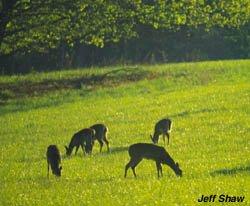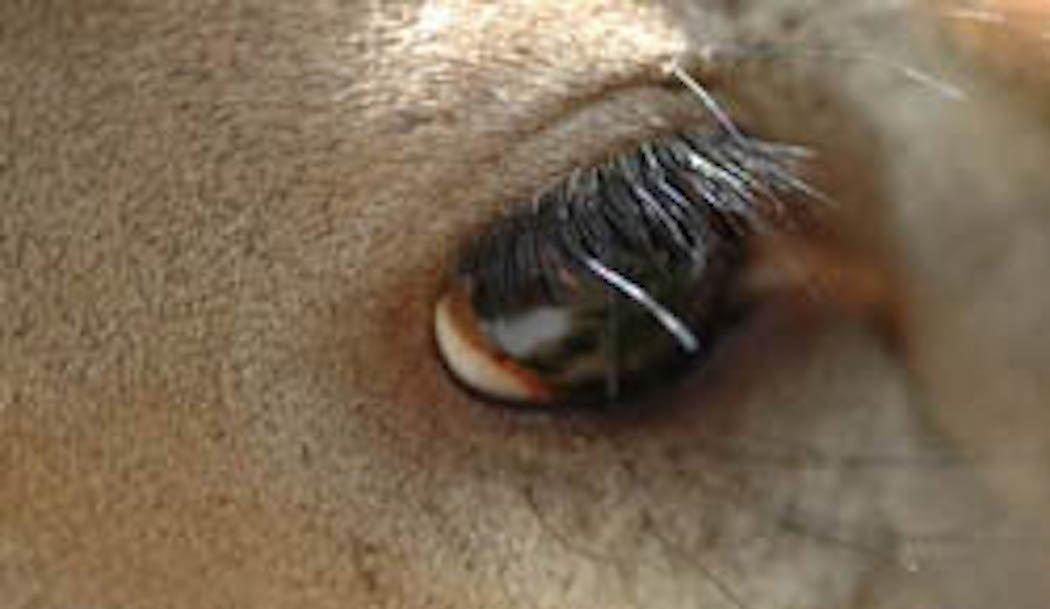Understanding How Deer See Will Affect How You Hunt Them
Anyone who hunts deer quickly learns that the animal's primary survival tool is its remarkable ability to accurately detect and identify even the most subtle smells. Let a deer pick up your scent and it's game over. And benefiting from its mobile, oversized ears, it can quickly detect the slightest of sounds -- such as clothing brushing against a small branch as a hunter moves, or the click of a gun's safety being released. Given, the deer's sense of smell and hearing (to a lesser extent) is far superior to ours, but what about its eyesight? How does it really see the world, especially when compared to what we see? Can deer see orange? Are they color blind? Do they see in just black and white? Is their vision good or poor?
Realtree asked one of the nation's foremost experts on animal ophthalmology -- the study and treatment of animal eye diseases and traits -- Dr. William W. Miller, professor of veterinary ophthalmology at Mississippi State University. Miller is also an avid deer hunter.
DEER EYE ANATOMY
To understand what deer see you have to know a little bit about the anatomy of their eyes, Miller says. Let's begin with the front of the eye and work our way to the back. The front of the eye is the cornea. The cornea is clear and serves as the window through which light enters the eye. Like most herbivores (cows, elk, horses) deer have a large cornea that allows a maximum amount of light to enter the eye. Its large size provides for a wide field of view, giving optimum peripheral vision.
The next aid to the deer's vision is the pupil, the opening in the iris through which light passes to reach the retina. Since deer are herbivores, they graze or browse. The pupil of the deer, like those of cattle, elk, sheep, and caribou, for example, are oval or rectangular with the long axis of the pupil parallel to the horizon. You have to remember deer and the other examples are prey species, or designed to be eaten by predators."

Think about the last time you observed a number of deer in a field. They did not graze all oriented in the same direction but with slightly different angles. Orienting at different angles allows the blind spot of one animal to be covered by another animal, again reducing the opportunity for Mr. Wolf to slip up on any individual deer.
DEER SPORT SUNGLASSES
Another interesting feature, located along the top edge of the pupil, is called the corpra nigrans. The corpra nigrans is a projection of the iris into the anterior chamber of the eye, the area located between the iris and cornea," Miller said. "Some of the functions of the corpra nigrans are unknown. One function the corpra nigrans does serve is that of an internal sun shield, similar to the bill on a baseball cap. Think about the last time you walked outside into the bright sunlight without a cap or sunglasses. You could hardly see because of the brightness and glare, making your first instinct to shield your eyes with your hand. Deer don't have a way to externally reduce the light entering the eye on bright days, but with the corpra nigrans they can limit the bright light and reduce glare."
THE LIGHT COLLECTOR
The last part of the deer eye to consider is the retina. Think of the eye as a camera and the retina is equivalent to the film in a camera," Miller said, "The retina collects the light, processes the light into an image and transmits that image to the brain where the image is interpreted. Many types of cells compose the retina and may be divided into inner retinal cells and outer retinal cells."
Compass360 GALE Jacket in Realtree Xtra and MAX-5
Outer retinal cells are called photoreceptor cells. Inner retinal cells are all the cells that provide support for the photoreceptor cells, process the electrical impulses produced by photoreceptor cells and transmit the signal to the brain. Photoreceptor cells collect the light and produce an electrical impulse based on the type of light contacting the cell. Two main types of photoreceptor cells are rods and cones. Rods are photoreceptor cells, designed for vision in low-light conditions. Rods are located throughout the retina with the highest concentration of cells in the peripheral retina. Cones function predominately in bright light. Cones have special chemicals, photopigments, within them that allow them to respond to specific wavelengths or colors of lights.
Deer have two types of cones and are termed dichromatics or having the ability to sense two colors of light. Man is a trichromatic species and is thus able to see all three primary colors and the various combinations of the three colors. Cones are useful to detect stationary objects and for vision in bright light.
If you have ever had a deer stand in the road in front of your headlights and seen the red-orange reflection of deer's eyes shinning back, then you have seen the tapetum at work.
Deer have photopigments to sense two colors and allow for determining the range of hues between those colors. Research has shown deer to have photopigments that can detect colors in the blue and green range. Input from rods may also be used by deer to further discriminate colors. Of course deer may not interpret colors in the same manner humans do, but it makes sense for deer to have sensitivities to blue and green colors. Determination of various shades of green may be useful in identification of edible plants. Blue light discrimination aids vision in low light conditions.
TOOLS FOR NIGHTVISION
One last piece of anatomy gives deer an advantage in dim light, the tapetum," Miller said. "The tapetum is a reflective layer of tissue just behind the retina. After light strikes the retina, any that is not absorbed will pass through the retina and contact the tapetum. The tapetum serves as a mirror to reflect light back onto the retina, giving the retina a second chance. The tapetum allows low levels of light to be magnified. If you have ever shined a light across a field and seen the red-orange reflection of deer's eyes shinning back, then you have seen the tapetum at work."
HUNTING STRATEGIES
Okay, how does all this allow deer to survive in their world," Miller said. "How do we use what we know to our advantage to harvest a quality deer? We need to remember deer are designed to detect movement, especially movement along their horizon. The more movement and the faster the movement, the more likely we are to be detected. Since the pupil is horizontal rectangle with the upper portions shielded by the corpra nigrans we can use that to our advantage by hunting from elevated positions. Putting ourselves above the horizon is why treestands are effective. How the deer's ability to detect colors in the blue and green spectrum influences our choice of camouflage patterns is yet to be determined."
Selecting a camo pattern that blends best with the conditions you are hunting will aid concealment.
Most camo patterns are designed to attract the hunter and hide the hunter from other hunters rather than from game. Most camo patterns will work well as long as movements are slow and kept to a minimum. Selecting a camo pattern that blends best with the conditions you are hunting will aid concealment. A springtime green pattern will certainly be out of place when worn in a treestand in December. Avoiding shades of blue, either early in the morning or late in the evening, should help avoid detection. Deer do not have the types and concentration of photoreceptor cells to accurately determine what predator is approaching, but do have excellent peripheral vision. When they detect movement that is out of place with their environment their first instinct is to run away from the possible danger. The deer's excellent peripheral vision is important to keep in mind when multiple deer are present since, together, they can keep a 360-degree visual of their surroundings.
Editor's note: This was originally published August 10, 2006.
Are you a deer hunter thirsty for knowledge? Check out our stories, videos and hard-hitting how-to's on deer hunting.








